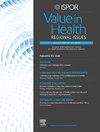基于目前证据的捷克全国试点筛查计划对妊娠亚临床甲状腺功能减退症普遍筛查的成本-效果分析
IF 1.4
Q3 HEALTH CARE SCIENCES & SERVICES
引用次数: 0
摘要
目的2023年,捷克内分泌学会指南引入妊娠前三个月普遍筛查促甲状腺激素(TSH)。我们建立了增量成本-效果比(ICER)、预算影响(BI)和新内分泌转诊(ER)的模型,用于(1)与当前测试相比,TSH筛查亚临床甲状腺功能减退;(2)扩展到抗甲状腺过氧化物酶抗体(anti-TPO)。方法假设左旋甲状腺素可降低妊娠期高血压、流产、早产风险,抗tpo检测可提高产后甲状腺炎的诊断,建立决策树。模型的参数化使用了国家试点筛选项目中可获得的最佳证据、概率和效用。ICER与每质量调整生命年(QALY) 47 430欧元的支付意愿阈值进行了比较。结果:每年预期10万例妊娠,引入全民TSH筛查将获得32.9(- 40至91.7)例产妇QALY, 65(45-90)例流产和52(30-77)例早产,ICER为2035欧元/QALY(2315/3000模拟成本效益),BI为659 756(439 993-895 993)欧元,ER为2290(1883-2728)(随机对照试验水平证据)。使用抗tpo扩展TSH筛查将额外获得111(- 398至604)个QALY, ICER为每QALY 15 703欧元(1945/3000模拟具有成本效益),BI为1 746 486欧元(1 241 391-2 350540)欧元,ER为6927欧元(6121-7765)(低水平证据)。结论TSH的普遍筛查和抗tpo的扩展是具有成本效益的。TSH筛查对人群的益处不大,但BI很低。反tpo模型基于弱证据,产生重要的BI。本文章由计算机程序翻译,如有差异,请以英文原文为准。
Cost-Effectiveness Analysis of Universal Screening for Subclinical Hypothyroidism in Pregnancy Based on the Czech Nation-Wide Pilot Screening Program in Light of Current Evidence
Objectives
In 2023, the Czech Guideline by Endocrinology society introduced universal screening of thyrotropin (TSH) in the first trimester of pregnancy. We modeled the incremental cost-effectiveness ratio (ICER), budget impact (BI), and new endocrinology referrals (ER) for universal screening of (1) TSH for subclinical hypothyroidism compared with the current testing and (2) extension to anti-thyroid peroxidase antibodies (anti-TPO).
Methods
A decision tree was built assuming that levothyroxine reduces the risks of gestational hypertension, miscarriage, and preterm birth and anti-TPO test improves diagnosis of postpartum thyroiditis. Models were parametrized using the best available evidence, probabilities, and utilities from the national pilot screening program. ICER was compared with a willingness-to-pay threshold of 47 430 EUR per quality-adjusted life year (QALY).
Results
Expecting 100 000 pregnancies yearly, introduction of universal TSH screening will result in 32.9 (−40 to 91.7) maternal QALYs gained, 65 (45-90) miscarriages and 52 (30-77) preterm deliveries prevented, with an ICER of 20 035 EUR/QALY (2315/3000 simulations cost-effective), the BI of 659 756 (439 993-895 993) EUR, and 2290 (1883-2728) ER (randomized-controlled-trial-level evidence). The extension of the TSH screening with anti-TPO will bring additional 111 (−398 to 604) QALY gained, ICER of 15 703 EUR per QALY (1945/3000 simulations cost-effective), the BI of 1 746 486 (1 241 391-2 350540) EUR, and 6927 (6121-7765) ER (low-level evidence).
Conclusions
Universal screening of TSH and extension with anti-TPO appear to be cost-effective. The population benefits of TSH screening are modest, but the BI is low. The model for anti-TPO is based on weak evidence and generates important BI.
求助全文
通过发布文献求助,成功后即可免费获取论文全文。
去求助
来源期刊

Value in health regional issues
Pharmacology, Toxicology and Pharmaceutics-Pharmacology, Toxicology and Pharmaceutics (miscellaneous)
CiteScore
2.60
自引率
5.00%
发文量
127
 求助内容:
求助内容: 应助结果提醒方式:
应助结果提醒方式:


